The Fundamental Role of Trait-Based Efficacy on Leadership Performance
VerifiedAdded on 2021/08/03
|14
|3957
|30
Report
AI Summary
This report, prepared for the University of Greenwich (Vietnam), delves into the significance of trait-based leadership and its impact on leadership performance. It examines the Zaccaro et al. (2004) model, which emphasizes the roles of distal (trait-based) and proximal attributes, alongside si...
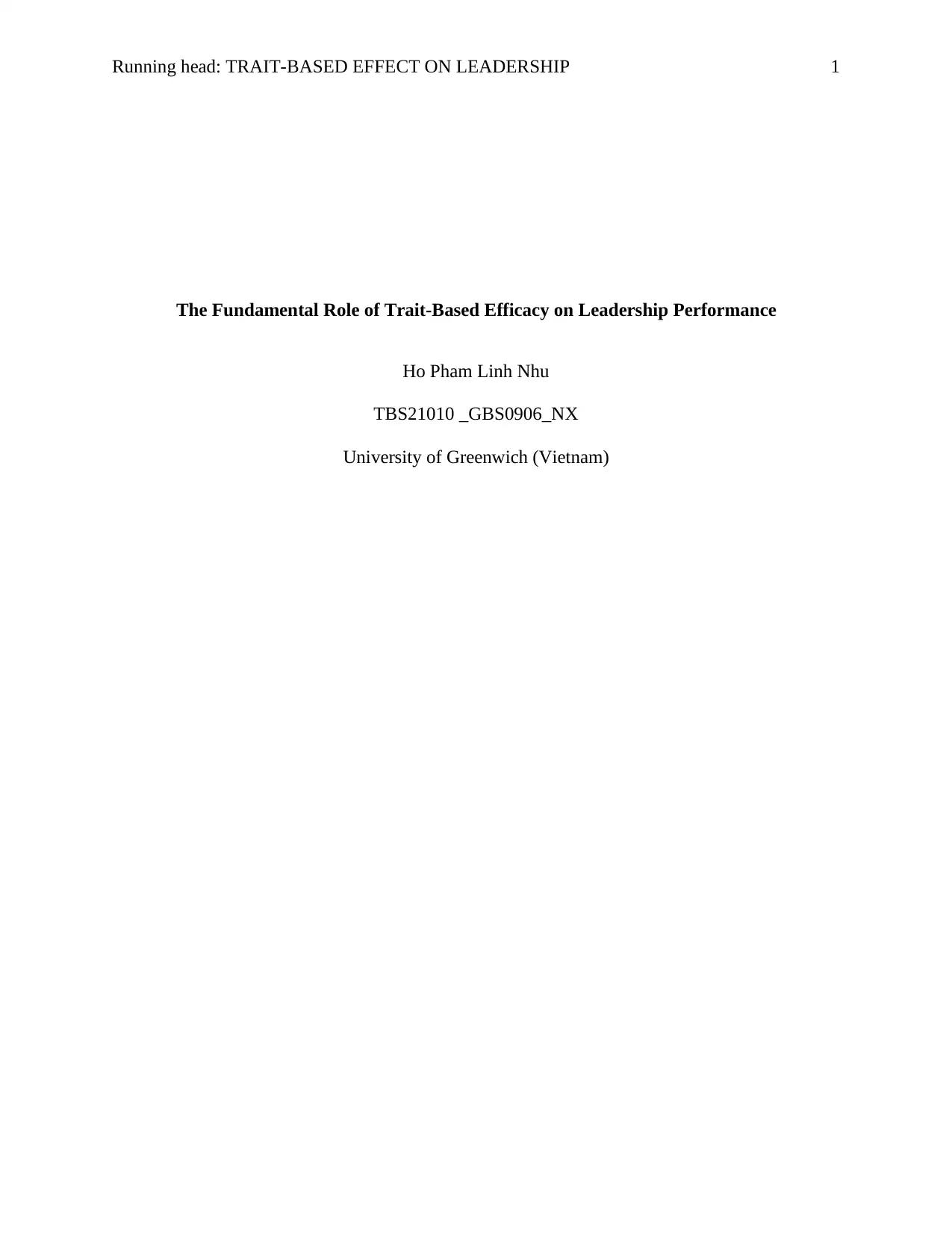
Running head: TRAIT-BASED EFFECT ON LEADERSHIP 1
The Fundamental Role of Trait-Based Efficacy on Leadership Performance
Ho Pham Linh Nhu
TBS21010 _GBS0906_NX
University of Greenwich (Vietnam)
The Fundamental Role of Trait-Based Efficacy on Leadership Performance
Ho Pham Linh Nhu
TBS21010 _GBS0906_NX
University of Greenwich (Vietnam)
Paraphrase This Document
Need a fresh take? Get an instant paraphrase of this document with our AI Paraphraser

TRAIT-BASED EFFECT ON LEADERSHIP 2
Abstract
The purpose of this material is to describe the priority rank of trait-based roles on leadership
productivity, which was forgotten and underestimated for a while before the rebirth. Besides that,
the analysis mainly emphasizes the effectiveness of the Leadership model (Zaccaro, Kemp &
Bader, 2004) about the remote attributes plus their cause-and-effect prominence compared to the
customized features that suffer from the impact of external factors – situations. This mechanism
showed enough aggregated matters that should combine for leading to the list of final results.
Furthermore, I recommend much more effort into interpreting the hidden risks from close-end
characteristics to finally drawing the elucidated conclusion.
Keywords: trait-based leadership, leadership theories
Abstract
The purpose of this material is to describe the priority rank of trait-based roles on leadership
productivity, which was forgotten and underestimated for a while before the rebirth. Besides that,
the analysis mainly emphasizes the effectiveness of the Leadership model (Zaccaro, Kemp &
Bader, 2004) about the remote attributes plus their cause-and-effect prominence compared to the
customized features that suffer from the impact of external factors – situations. This mechanism
showed enough aggregated matters that should combine for leading to the list of final results.
Furthermore, I recommend much more effort into interpreting the hidden risks from close-end
characteristics to finally drawing the elucidated conclusion.
Keywords: trait-based leadership, leadership theories
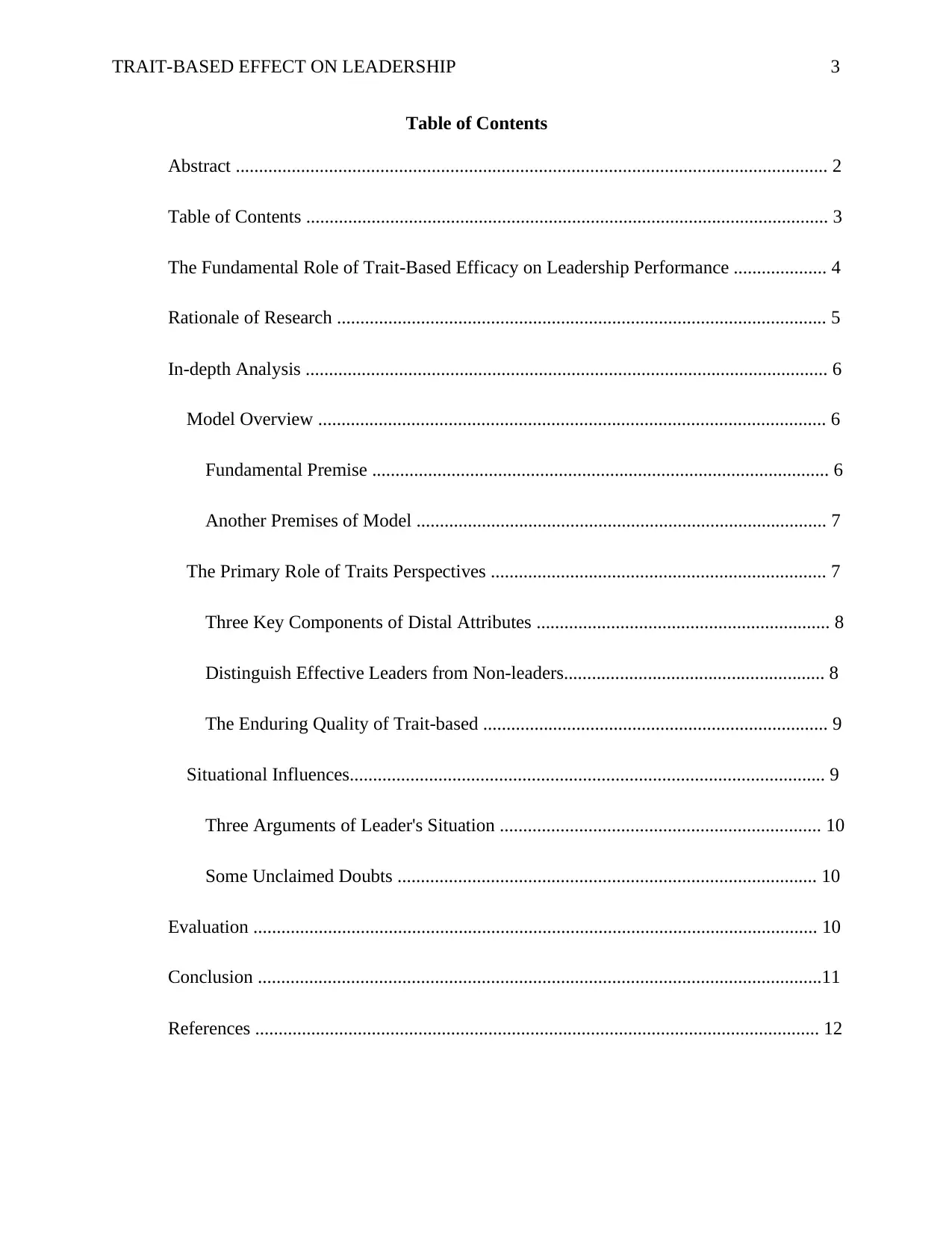
TRAIT-BASED EFFECT ON LEADERSHIP 3
Table of Contents
Abstract ............................................................................................................................... 2
Table of Contents ................................................................................................................ 3
The Fundamental Role of Trait-Based Efficacy on Leadership Performance .................... 4
Rationale of Research ......................................................................................................... 5
In-depth Analysis ................................................................................................................ 6
Model Overview ............................................................................................................. 6
Fundamental Premise .................................................................................................. 6
Another Premises of Model ........................................................................................ 7
The Primary Role of Traits Perspectives ........................................................................ 7
Three Key Components of Distal Attributes ............................................................... 8
Distinguish Effective Leaders from Non-leaders........................................................ 8
The Enduring Quality of Trait-based .......................................................................... 9
Situational Influences...................................................................................................... 9
Three Arguments of Leader's Situation ..................................................................... 10
Some Unclaimed Doubts .......................................................................................... 10
Evaluation ......................................................................................................................... 10
Conclusion .........................................................................................................................11
References ......................................................................................................................... 12
Table of Contents
Abstract ............................................................................................................................... 2
Table of Contents ................................................................................................................ 3
The Fundamental Role of Trait-Based Efficacy on Leadership Performance .................... 4
Rationale of Research ......................................................................................................... 5
In-depth Analysis ................................................................................................................ 6
Model Overview ............................................................................................................. 6
Fundamental Premise .................................................................................................. 6
Another Premises of Model ........................................................................................ 7
The Primary Role of Traits Perspectives ........................................................................ 7
Three Key Components of Distal Attributes ............................................................... 8
Distinguish Effective Leaders from Non-leaders........................................................ 8
The Enduring Quality of Trait-based .......................................................................... 9
Situational Influences...................................................................................................... 9
Three Arguments of Leader's Situation ..................................................................... 10
Some Unclaimed Doubts .......................................................................................... 10
Evaluation ......................................................................................................................... 10
Conclusion .........................................................................................................................11
References ......................................................................................................................... 12
⊘ This is a preview!⊘
Do you want full access?
Subscribe today to unlock all pages.

Trusted by 1+ million students worldwide
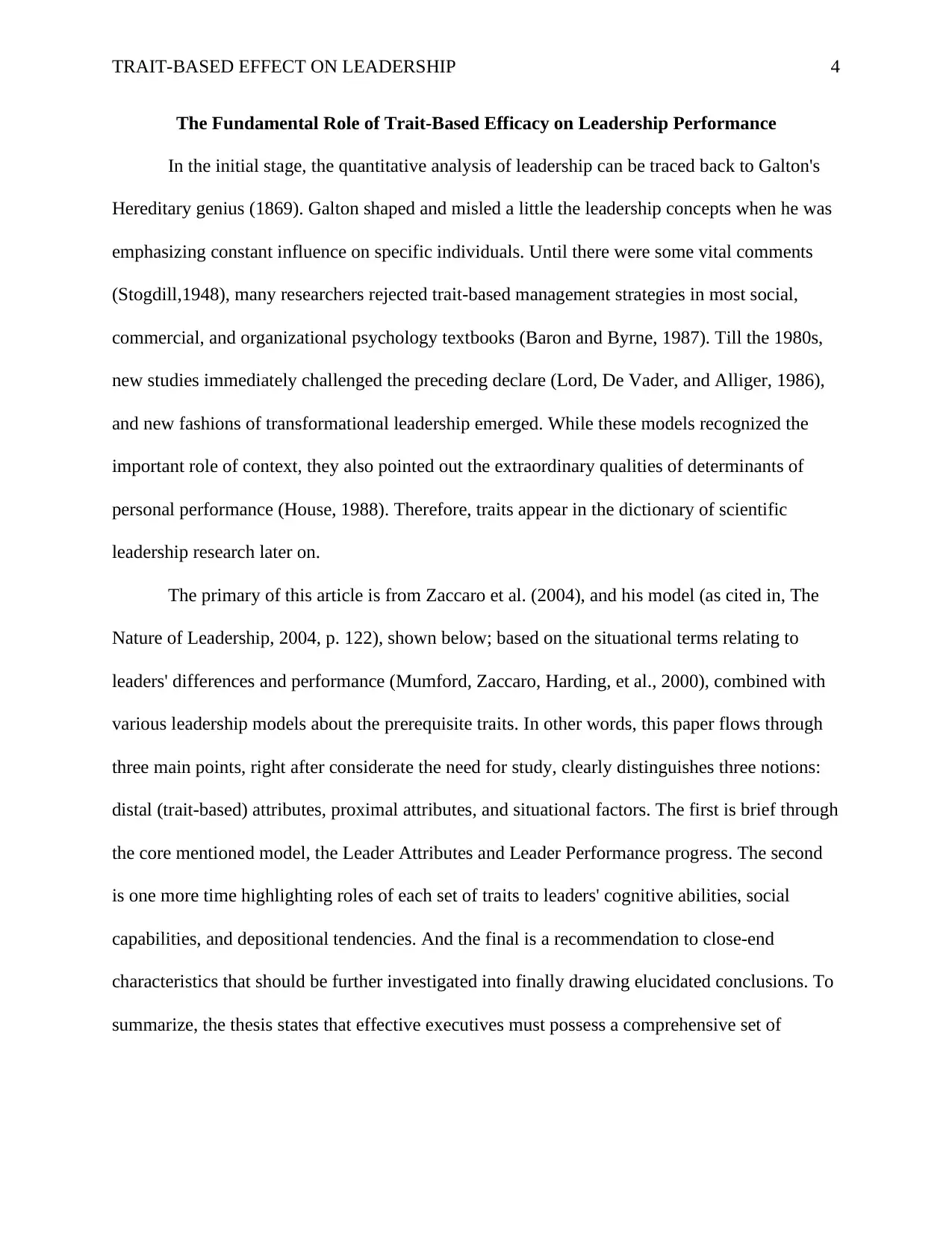
TRAIT-BASED EFFECT ON LEADERSHIP 4
The Fundamental Role of Trait-Based Efficacy on Leadership Performance
In the initial stage, the quantitative analysis of leadership can be traced back to Galton's
Hereditary genius (1869). Galton shaped and misled a little the leadership concepts when he was
emphasizing constant influence on specific individuals. Until there were some vital comments
(Stogdill,1948), many researchers rejected trait-based management strategies in most social,
commercial, and organizational psychology textbooks (Baron and Byrne, 1987). Till the 1980s,
new studies immediately challenged the preceding declare (Lord, De Vader, and Alliger, 1986),
and new fashions of transformational leadership emerged. While these models recognized the
important role of context, they also pointed out the extraordinary qualities of determinants of
personal performance (House, 1988). Therefore, traits appear in the dictionary of scientific
leadership research later on.
The primary of this article is from Zaccaro et al. (2004), and his model (as cited in, The
Nature of Leadership, 2004, p. 122), shown below; based on the situational terms relating to
leaders' differences and performance (Mumford, Zaccaro, Harding, et al., 2000), combined with
various leadership models about the prerequisite traits. In other words, this paper flows through
three main points, right after considerate the need for study, clearly distinguishes three notions:
distal (trait-based) attributes, proximal attributes, and situational factors. The first is brief through
the core mentioned model, the Leader Attributes and Leader Performance progress. The second
is one more time highlighting roles of each set of traits to leaders' cognitive abilities, social
capabilities, and depositional tendencies. And the final is a recommendation to close-end
characteristics that should be further investigated into finally drawing elucidated conclusions. To
summarize, the thesis states that effective executives must possess a comprehensive set of
The Fundamental Role of Trait-Based Efficacy on Leadership Performance
In the initial stage, the quantitative analysis of leadership can be traced back to Galton's
Hereditary genius (1869). Galton shaped and misled a little the leadership concepts when he was
emphasizing constant influence on specific individuals. Until there were some vital comments
(Stogdill,1948), many researchers rejected trait-based management strategies in most social,
commercial, and organizational psychology textbooks (Baron and Byrne, 1987). Till the 1980s,
new studies immediately challenged the preceding declare (Lord, De Vader, and Alliger, 1986),
and new fashions of transformational leadership emerged. While these models recognized the
important role of context, they also pointed out the extraordinary qualities of determinants of
personal performance (House, 1988). Therefore, traits appear in the dictionary of scientific
leadership research later on.
The primary of this article is from Zaccaro et al. (2004), and his model (as cited in, The
Nature of Leadership, 2004, p. 122), shown below; based on the situational terms relating to
leaders' differences and performance (Mumford, Zaccaro, Harding, et al., 2000), combined with
various leadership models about the prerequisite traits. In other words, this paper flows through
three main points, right after considerate the need for study, clearly distinguishes three notions:
distal (trait-based) attributes, proximal attributes, and situational factors. The first is brief through
the core mentioned model, the Leader Attributes and Leader Performance progress. The second
is one more time highlighting roles of each set of traits to leaders' cognitive abilities, social
capabilities, and depositional tendencies. And the final is a recommendation to close-end
characteristics that should be further investigated into finally drawing elucidated conclusions. To
summarize, the thesis states that effective executives must possess a comprehensive set of
Paraphrase This Document
Need a fresh take? Get an instant paraphrase of this document with our AI Paraphraser

TRAIT-BASED EFFECT ON LEADERSHIP 5
cognitive skills, social skills, and personality tendencies, especially when each set of
characteristics affects another.
Figure 1:
A Model of Leader Attributes and Leader Performance
Note. From “Leader Traits and Attributes,” by S. J. Zaccaro, C. Kemp, & P. Bader, 2004, in J.
Antonakis, A. T. Cianciolo, and R. J. Sternberg (Eds.), The Nature of Leadership (p. 122),
Thousand Oaks, CA: Sage. Copyright 2004 by Sage Publications. Reprinted with permission.
Rationale of Research
These views on leadership characteristics and leadership situations evolved from various
early leadership perspectives. Although the ups and downs (and resurgence) of leader traits are
often described in clear terms in most textbooks, the reality of their prominence in leadership
research is even more ambiguous (Day & Zaccaro, 2007). In reality, over the following thirty
years, numerous readings denied that the individual qualities of pioneers were diverse from
others. However, because the concept of situational constancy was examined and found that may
necessitate alternative leader performance standards, this type of transformation cannot be
cognitive skills, social skills, and personality tendencies, especially when each set of
characteristics affects another.
Figure 1:
A Model of Leader Attributes and Leader Performance
Note. From “Leader Traits and Attributes,” by S. J. Zaccaro, C. Kemp, & P. Bader, 2004, in J.
Antonakis, A. T. Cianciolo, and R. J. Sternberg (Eds.), The Nature of Leadership (p. 122),
Thousand Oaks, CA: Sage. Copyright 2004 by Sage Publications. Reprinted with permission.
Rationale of Research
These views on leadership characteristics and leadership situations evolved from various
early leadership perspectives. Although the ups and downs (and resurgence) of leader traits are
often described in clear terms in most textbooks, the reality of their prominence in leadership
research is even more ambiguous (Day & Zaccaro, 2007). In reality, over the following thirty
years, numerous readings denied that the individual qualities of pioneers were diverse from
others. However, because the concept of situational constancy was examined and found that may
necessitate alternative leader performance standards, this type of transformation cannot be
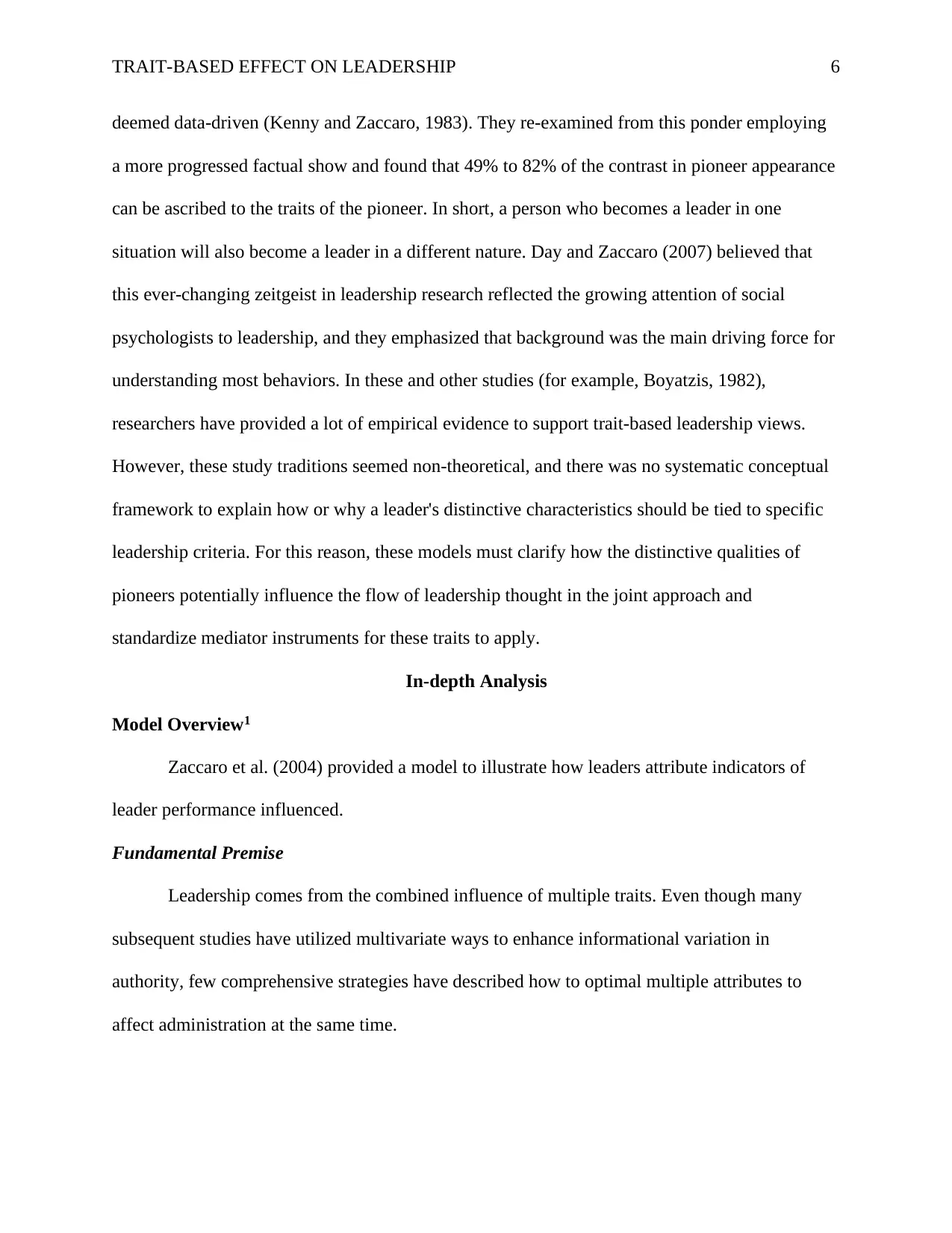
TRAIT-BASED EFFECT ON LEADERSHIP 6
deemed data-driven (Kenny and Zaccaro, 1983). They re-examined from this ponder employing
a more progressed factual show and found that 49% to 82% of the contrast in pioneer appearance
can be ascribed to the traits of the pioneer. In short, a person who becomes a leader in one
situation will also become a leader in a different nature. Day and Zaccaro (2007) believed that
this ever-changing zeitgeist in leadership research reflected the growing attention of social
psychologists to leadership, and they emphasized that background was the main driving force for
understanding most behaviors. In these and other studies (for example, Boyatzis, 1982),
researchers have provided a lot of empirical evidence to support trait-based leadership views.
However, these study traditions seemed non-theoretical, and there was no systematic conceptual
framework to explain how or why a leader's distinctive characteristics should be tied to specific
leadership criteria. For this reason, these models must clarify how the distinctive qualities of
pioneers potentially influence the flow of leadership thought in the joint approach and
standardize mediator instruments for these traits to apply.
In-depth Analysis
Model Overview1
Zaccaro et al. (2004) provided a model to illustrate how leaders attribute indicators of
leader performance influenced.
Fundamental Premise
Leadership comes from the combined influence of multiple traits. Even though many
subsequent studies have utilized multivariate ways to enhance informational variation in
authority, few comprehensive strategies have described how to optimal multiple attributes to
affect administration at the same time.
deemed data-driven (Kenny and Zaccaro, 1983). They re-examined from this ponder employing
a more progressed factual show and found that 49% to 82% of the contrast in pioneer appearance
can be ascribed to the traits of the pioneer. In short, a person who becomes a leader in one
situation will also become a leader in a different nature. Day and Zaccaro (2007) believed that
this ever-changing zeitgeist in leadership research reflected the growing attention of social
psychologists to leadership, and they emphasized that background was the main driving force for
understanding most behaviors. In these and other studies (for example, Boyatzis, 1982),
researchers have provided a lot of empirical evidence to support trait-based leadership views.
However, these study traditions seemed non-theoretical, and there was no systematic conceptual
framework to explain how or why a leader's distinctive characteristics should be tied to specific
leadership criteria. For this reason, these models must clarify how the distinctive qualities of
pioneers potentially influence the flow of leadership thought in the joint approach and
standardize mediator instruments for these traits to apply.
In-depth Analysis
Model Overview1
Zaccaro et al. (2004) provided a model to illustrate how leaders attribute indicators of
leader performance influenced.
Fundamental Premise
Leadership comes from the combined influence of multiple traits. Even though many
subsequent studies have utilized multivariate ways to enhance informational variation in
authority, few comprehensive strategies have described how to optimal multiple attributes to
affect administration at the same time.
⊘ This is a preview!⊘
Do you want full access?
Subscribe today to unlock all pages.

Trusted by 1+ million students worldwide
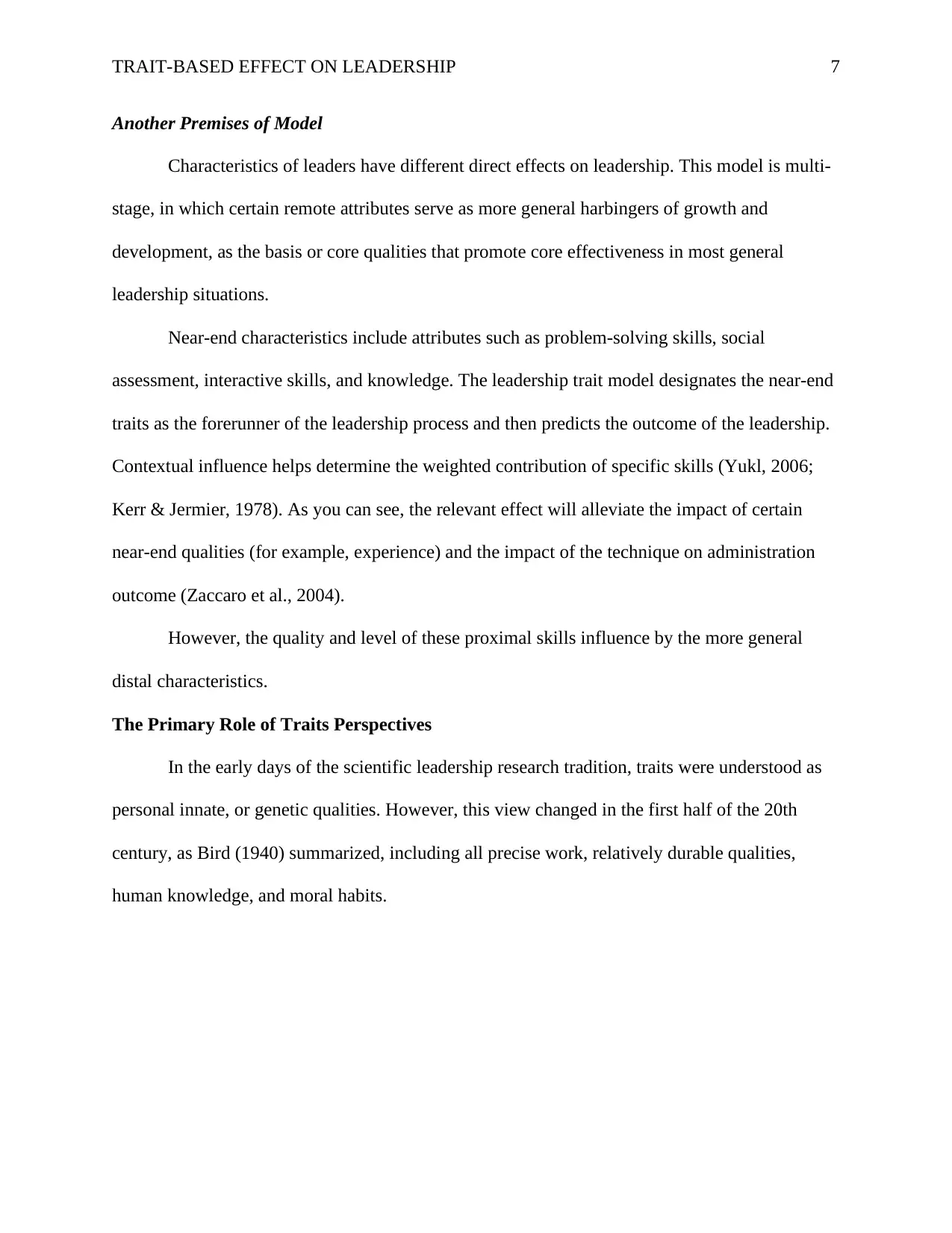
TRAIT-BASED EFFECT ON LEADERSHIP 7
Another Premises of Model
Characteristics of leaders have different direct effects on leadership. This model is multi-
stage, in which certain remote attributes serve as more general harbingers of growth and
development, as the basis or core qualities that promote core effectiveness in most general
leadership situations.
Near-end characteristics include attributes such as problem-solving skills, social
assessment, interactive skills, and knowledge. The leadership trait model designates the near-end
traits as the forerunner of the leadership process and then predicts the outcome of the leadership.
Contextual influence helps determine the weighted contribution of specific skills (Yukl, 2006;
Kerr & Jermier, 1978). As you can see, the relevant effect will alleviate the impact of certain
near-end qualities (for example, experience) and the impact of the technique on administration
outcome (Zaccaro et al., 2004).
However, the quality and level of these proximal skills influence by the more general
distal characteristics.
The Primary Role of Traits Perspectives
In the early days of the scientific leadership research tradition, traits were understood as
personal innate, or genetic qualities. However, this view changed in the first half of the 20th
century, as Bird (1940) summarized, including all precise work, relatively durable qualities,
human knowledge, and moral habits.
Another Premises of Model
Characteristics of leaders have different direct effects on leadership. This model is multi-
stage, in which certain remote attributes serve as more general harbingers of growth and
development, as the basis or core qualities that promote core effectiveness in most general
leadership situations.
Near-end characteristics include attributes such as problem-solving skills, social
assessment, interactive skills, and knowledge. The leadership trait model designates the near-end
traits as the forerunner of the leadership process and then predicts the outcome of the leadership.
Contextual influence helps determine the weighted contribution of specific skills (Yukl, 2006;
Kerr & Jermier, 1978). As you can see, the relevant effect will alleviate the impact of certain
near-end qualities (for example, experience) and the impact of the technique on administration
outcome (Zaccaro et al., 2004).
However, the quality and level of these proximal skills influence by the more general
distal characteristics.
The Primary Role of Traits Perspectives
In the early days of the scientific leadership research tradition, traits were understood as
personal innate, or genetic qualities. However, this view changed in the first half of the 20th
century, as Bird (1940) summarized, including all precise work, relatively durable qualities,
human knowledge, and moral habits.
Paraphrase This Document
Need a fresh take? Get an instant paraphrase of this document with our AI Paraphraser

TRAIT-BASED EFFECT ON LEADERSHIP 8
Three Key Components of Distal Attributes
To begin with, authority characteristics cannot be seen in confinement but maybe as
comprehensive traits that influence execution. As mentioned above, most researchers in
previous studies used mainly univariate methods to reveal the differences. In any case, complex
shapes like administration are seldom based on so few individual determinants (Yukl and Van
Armada, 1992).
The second component of the definition of leader traits involves the inclusion of
several personal qualities that promote the stability of effective leadership. Traits
traditionally refer to attributes of the personality. Be that as the qualities of each pioneer are
exceptionally wide, counting not as they were identity qualities, but too inspiration, values,
cognitive capacities, social and problem-solving aptitudes, and encounter. By and large talking,
the components that characterize pioneer characteristics here allude to the extent of qualities that
can reliably and dependably recognize. However, Judge et al. (2002) found that. Although
extraversion and openness showed consistent and similar influence sizes with leadership
effectiveness and emergence, other personality attributes showed inconsistent relationships with
these two sets of leadership standards. This does indicate that the difference between these two
standards may correspond to differences in individual predictions.
The third component of the definition of leadership traits designates leadership
attributes as relatively durable, which generates stability in cross-contexts in leadership
performance. Variability has always been the key to the pure situation in personality theory.
However, a review and summary of this argument and its possible solutions are beyond the scope
of this article.
Distinguish Effective Leaders from Non-leaders
Three Key Components of Distal Attributes
To begin with, authority characteristics cannot be seen in confinement but maybe as
comprehensive traits that influence execution. As mentioned above, most researchers in
previous studies used mainly univariate methods to reveal the differences. In any case, complex
shapes like administration are seldom based on so few individual determinants (Yukl and Van
Armada, 1992).
The second component of the definition of leader traits involves the inclusion of
several personal qualities that promote the stability of effective leadership. Traits
traditionally refer to attributes of the personality. Be that as the qualities of each pioneer are
exceptionally wide, counting not as they were identity qualities, but too inspiration, values,
cognitive capacities, social and problem-solving aptitudes, and encounter. By and large talking,
the components that characterize pioneer characteristics here allude to the extent of qualities that
can reliably and dependably recognize. However, Judge et al. (2002) found that. Although
extraversion and openness showed consistent and similar influence sizes with leadership
effectiveness and emergence, other personality attributes showed inconsistent relationships with
these two sets of leadership standards. This does indicate that the difference between these two
standards may correspond to differences in individual predictions.
The third component of the definition of leadership traits designates leadership
attributes as relatively durable, which generates stability in cross-contexts in leadership
performance. Variability has always been the key to the pure situation in personality theory.
However, a review and summary of this argument and its possible solutions are beyond the scope
of this article.
Distinguish Effective Leaders from Non-leaders
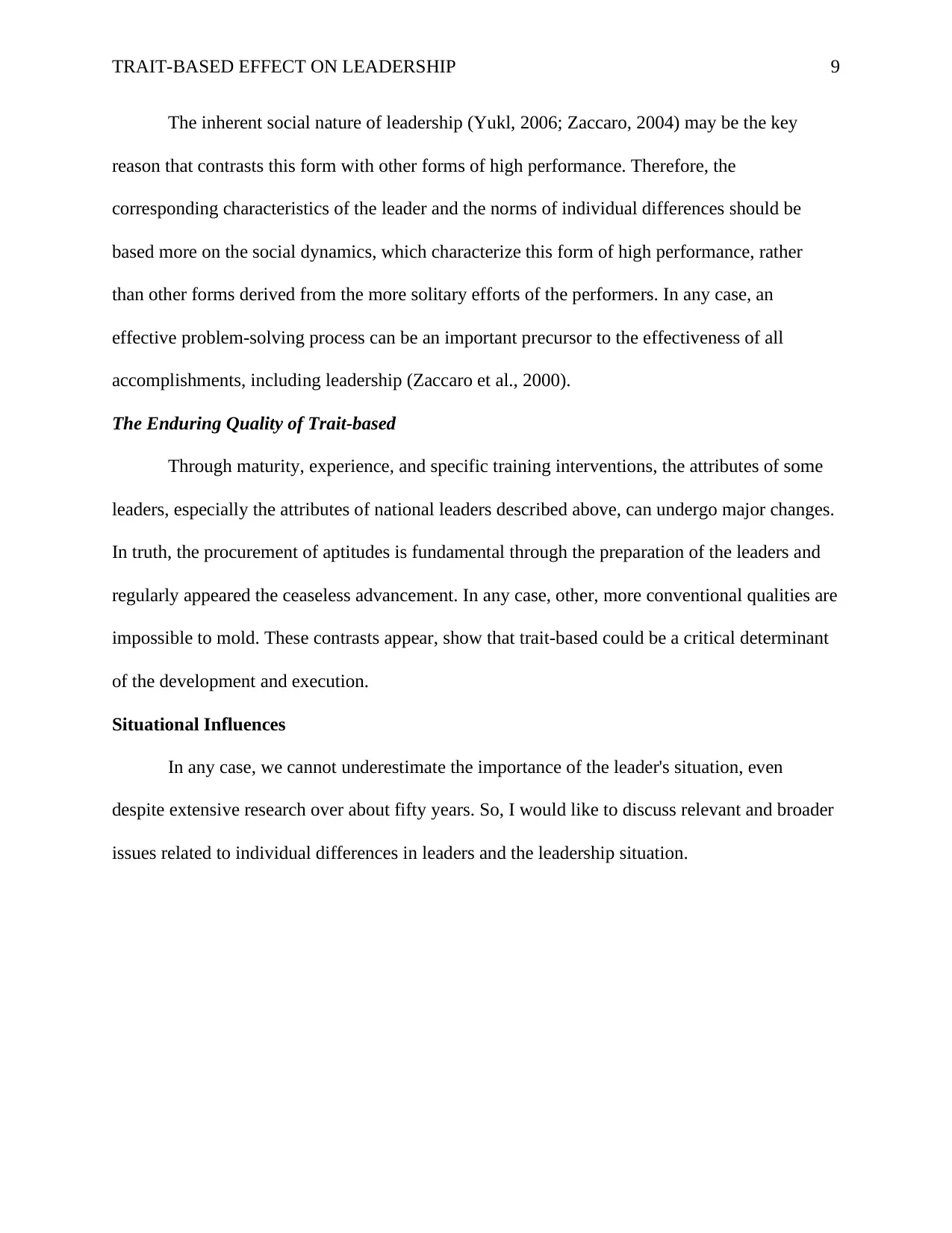
TRAIT-BASED EFFECT ON LEADERSHIP 9
The inherent social nature of leadership (Yukl, 2006; Zaccaro, 2004) may be the key
reason that contrasts this form with other forms of high performance. Therefore, the
corresponding characteristics of the leader and the norms of individual differences should be
based more on the social dynamics, which characterize this form of high performance, rather
than other forms derived from the more solitary efforts of the performers. In any case, an
effective problem-solving process can be an important precursor to the effectiveness of all
accomplishments, including leadership (Zaccaro et al., 2000).
The Enduring Quality of Trait-based
Through maturity, experience, and specific training interventions, the attributes of some
leaders, especially the attributes of national leaders described above, can undergo major changes.
In truth, the procurement of aptitudes is fundamental through the preparation of the leaders and
regularly appeared the ceaseless advancement. In any case, other, more conventional qualities are
impossible to mold. These contrasts appear, show that trait-based could be a critical determinant
of the development and execution.
Situational Influences
In any case, we cannot underestimate the importance of the leader's situation, even
despite extensive research over about fifty years. So, I would like to discuss relevant and broader
issues related to individual differences in leaders and the leadership situation.
The inherent social nature of leadership (Yukl, 2006; Zaccaro, 2004) may be the key
reason that contrasts this form with other forms of high performance. Therefore, the
corresponding characteristics of the leader and the norms of individual differences should be
based more on the social dynamics, which characterize this form of high performance, rather
than other forms derived from the more solitary efforts of the performers. In any case, an
effective problem-solving process can be an important precursor to the effectiveness of all
accomplishments, including leadership (Zaccaro et al., 2000).
The Enduring Quality of Trait-based
Through maturity, experience, and specific training interventions, the attributes of some
leaders, especially the attributes of national leaders described above, can undergo major changes.
In truth, the procurement of aptitudes is fundamental through the preparation of the leaders and
regularly appeared the ceaseless advancement. In any case, other, more conventional qualities are
impossible to mold. These contrasts appear, show that trait-based could be a critical determinant
of the development and execution.
Situational Influences
In any case, we cannot underestimate the importance of the leader's situation, even
despite extensive research over about fifty years. So, I would like to discuss relevant and broader
issues related to individual differences in leaders and the leadership situation.
⊘ This is a preview!⊘
Do you want full access?
Subscribe today to unlock all pages.

Trusted by 1+ million students worldwide
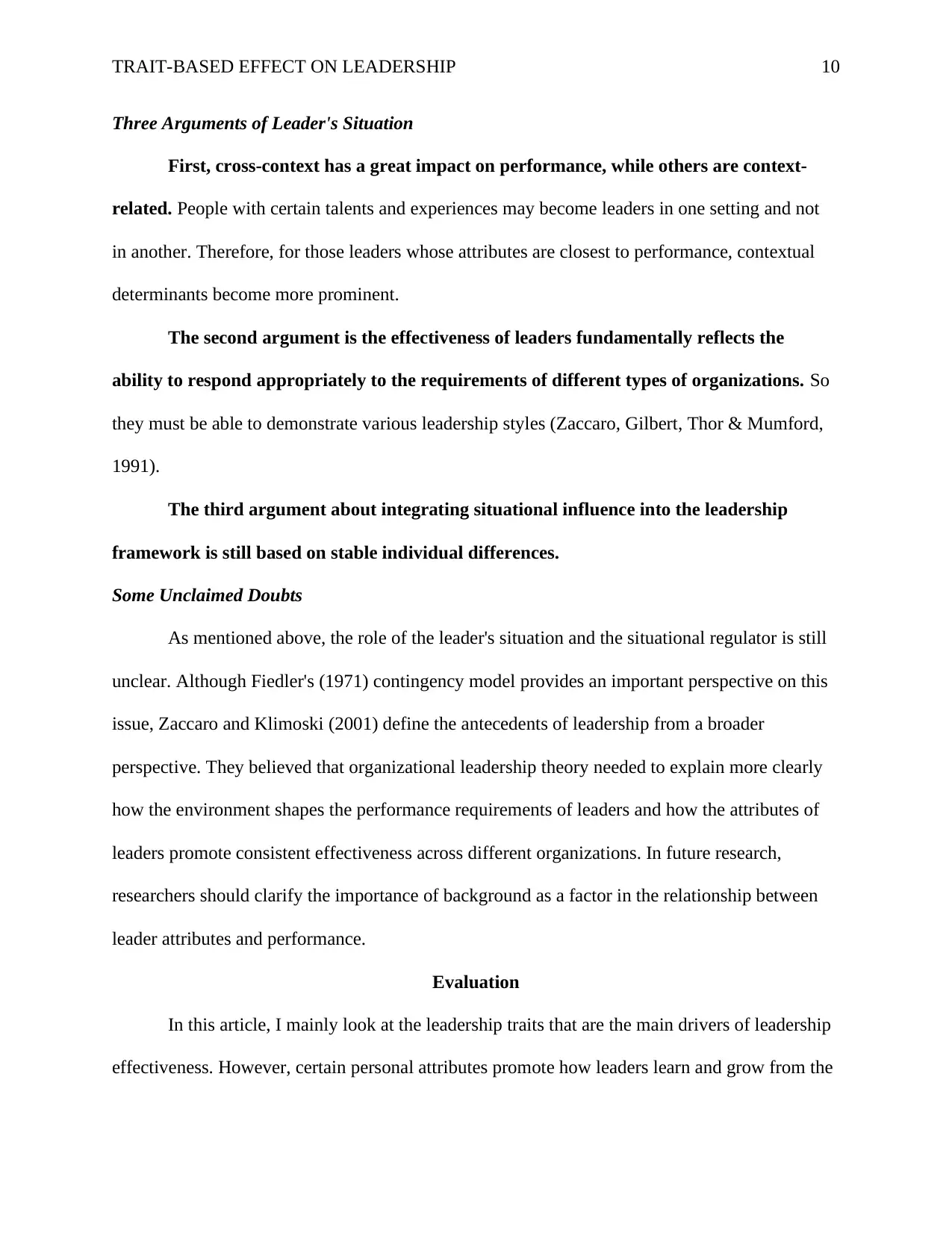
TRAIT-BASED EFFECT ON LEADERSHIP 10
Three Arguments of Leader's Situation
First, cross-context has a great impact on performance, while others are context-
related. People with certain talents and experiences may become leaders in one setting and not
in another. Therefore, for those leaders whose attributes are closest to performance, contextual
determinants become more prominent.
The second argument is the effectiveness of leaders fundamentally reflects the
ability to respond appropriately to the requirements of different types of organizations. So
they must be able to demonstrate various leadership styles (Zaccaro, Gilbert, Thor & Mumford,
1991).
The third argument about integrating situational influence into the leadership
framework is still based on stable individual differences.
Some Unclaimed Doubts
As mentioned above, the role of the leader's situation and the situational regulator is still
unclear. Although Fiedler's (1971) contingency model provides an important perspective on this
issue, Zaccaro and Klimoski (2001) define the antecedents of leadership from a broader
perspective. They believed that organizational leadership theory needed to explain more clearly
how the environment shapes the performance requirements of leaders and how the attributes of
leaders promote consistent effectiveness across different organizations. In future research,
researchers should clarify the importance of background as a factor in the relationship between
leader attributes and performance.
Evaluation
In this article, I mainly look at the leadership traits that are the main drivers of leadership
effectiveness. However, certain personal attributes promote how leaders learn and grow from the
Three Arguments of Leader's Situation
First, cross-context has a great impact on performance, while others are context-
related. People with certain talents and experiences may become leaders in one setting and not
in another. Therefore, for those leaders whose attributes are closest to performance, contextual
determinants become more prominent.
The second argument is the effectiveness of leaders fundamentally reflects the
ability to respond appropriately to the requirements of different types of organizations. So
they must be able to demonstrate various leadership styles (Zaccaro, Gilbert, Thor & Mumford,
1991).
The third argument about integrating situational influence into the leadership
framework is still based on stable individual differences.
Some Unclaimed Doubts
As mentioned above, the role of the leader's situation and the situational regulator is still
unclear. Although Fiedler's (1971) contingency model provides an important perspective on this
issue, Zaccaro and Klimoski (2001) define the antecedents of leadership from a broader
perspective. They believed that organizational leadership theory needed to explain more clearly
how the environment shapes the performance requirements of leaders and how the attributes of
leaders promote consistent effectiveness across different organizations. In future research,
researchers should clarify the importance of background as a factor in the relationship between
leader attributes and performance.
Evaluation
In this article, I mainly look at the leadership traits that are the main drivers of leadership
effectiveness. However, certain personal attributes promote how leaders learn and grow from the
Paraphrase This Document
Need a fresh take? Get an instant paraphrase of this document with our AI Paraphraser
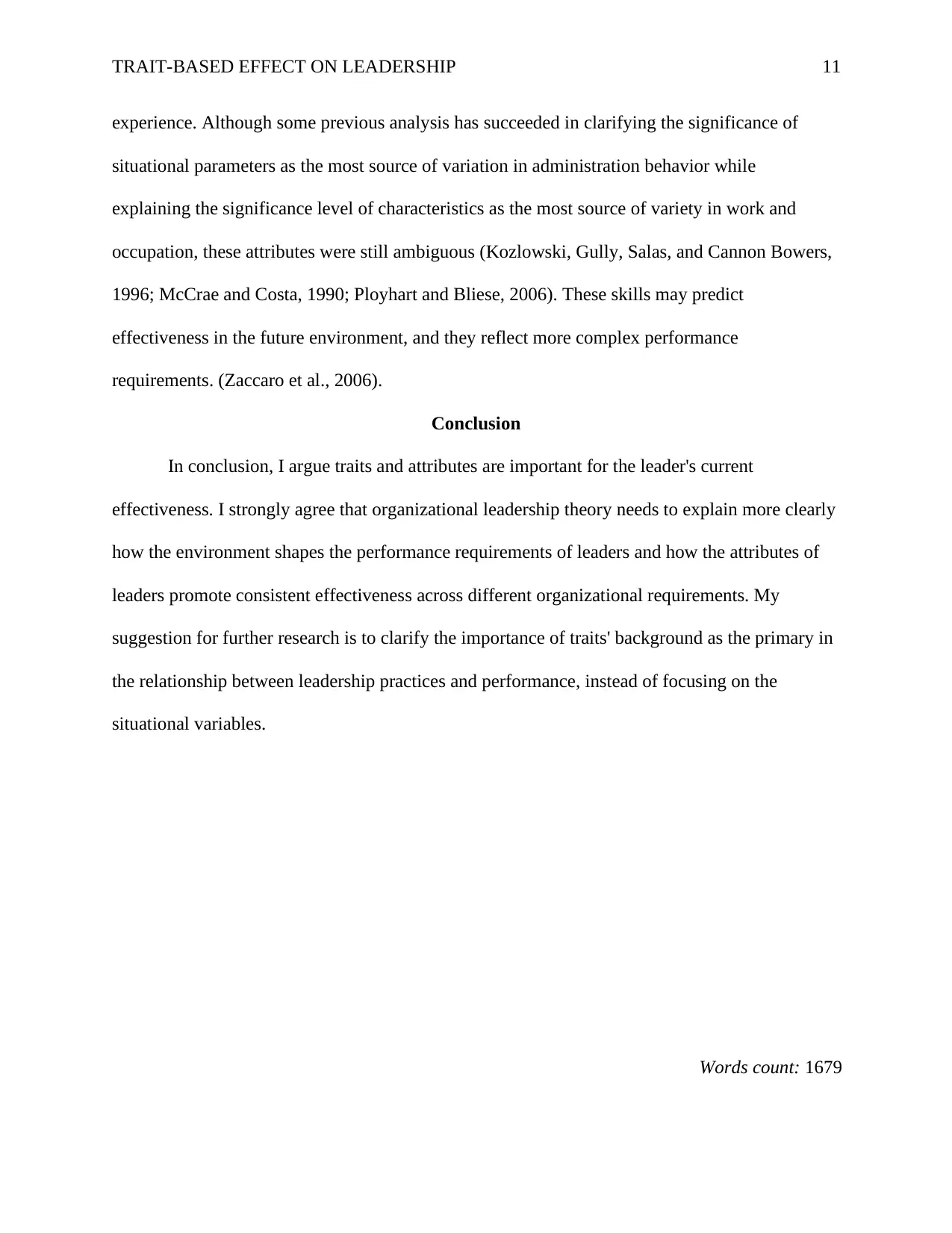
TRAIT-BASED EFFECT ON LEADERSHIP 11
experience. Although some previous analysis has succeeded in clarifying the significance of
situational parameters as the most source of variation in administration behavior while
explaining the significance level of characteristics as the most source of variety in work and
occupation, these attributes were still ambiguous (Kozlowski, Gully, Salas, and Cannon Bowers,
1996; McCrae and Costa, 1990; Ployhart and Bliese, 2006). These skills may predict
effectiveness in the future environment, and they reflect more complex performance
requirements. (Zaccaro et al., 2006).
Conclusion
In conclusion, I argue traits and attributes are important for the leader's current
effectiveness. I strongly agree that organizational leadership theory needs to explain more clearly
how the environment shapes the performance requirements of leaders and how the attributes of
leaders promote consistent effectiveness across different organizational requirements. My
suggestion for further research is to clarify the importance of traits' background as the primary in
the relationship between leadership practices and performance, instead of focusing on the
situational variables.
Words count: 1679
experience. Although some previous analysis has succeeded in clarifying the significance of
situational parameters as the most source of variation in administration behavior while
explaining the significance level of characteristics as the most source of variety in work and
occupation, these attributes were still ambiguous (Kozlowski, Gully, Salas, and Cannon Bowers,
1996; McCrae and Costa, 1990; Ployhart and Bliese, 2006). These skills may predict
effectiveness in the future environment, and they reflect more complex performance
requirements. (Zaccaro et al., 2006).
Conclusion
In conclusion, I argue traits and attributes are important for the leader's current
effectiveness. I strongly agree that organizational leadership theory needs to explain more clearly
how the environment shapes the performance requirements of leaders and how the attributes of
leaders promote consistent effectiveness across different organizational requirements. My
suggestion for further research is to clarify the importance of traits' background as the primary in
the relationship between leadership practices and performance, instead of focusing on the
situational variables.
Words count: 1679
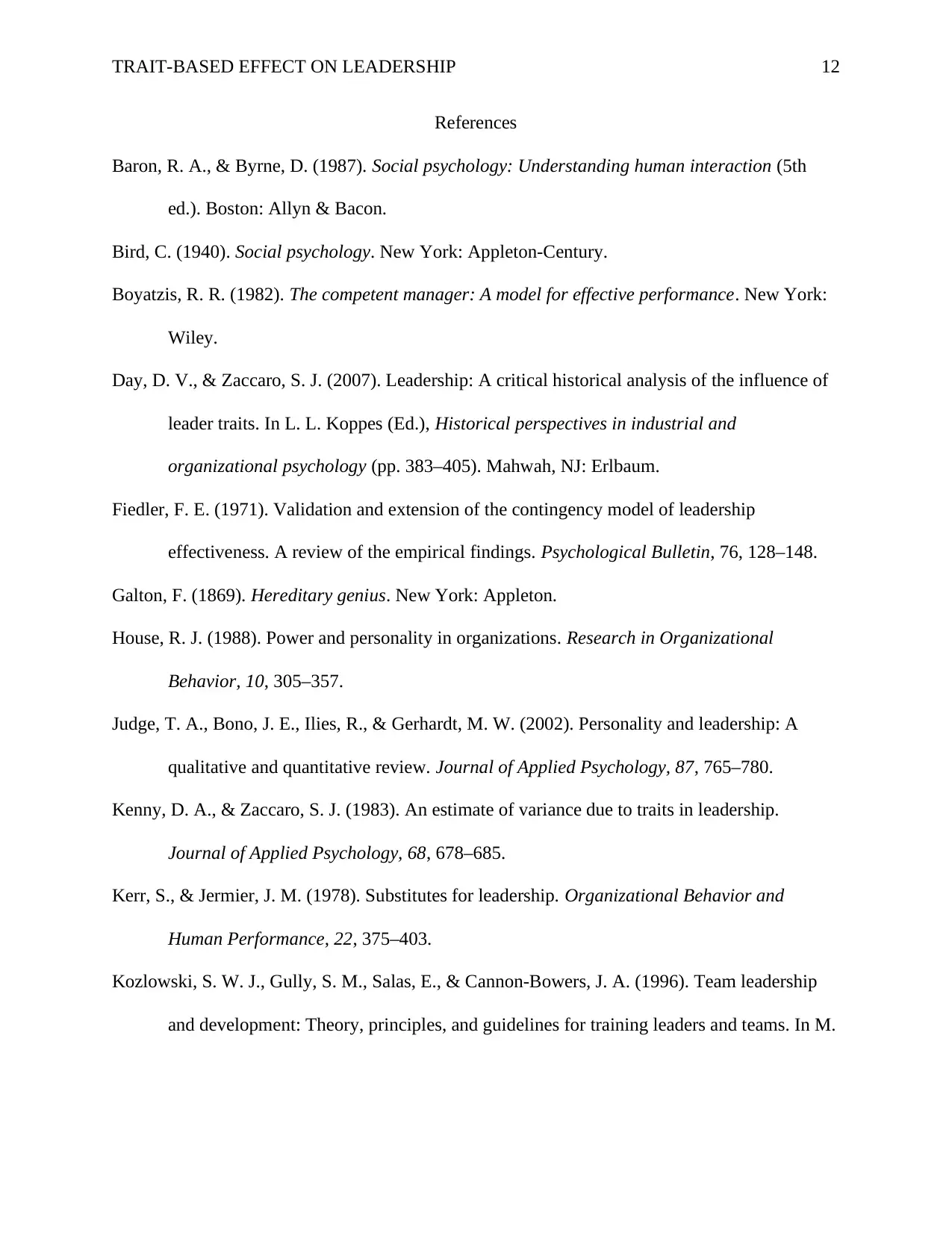
TRAIT-BASED EFFECT ON LEADERSHIP 12
References
Baron, R. A., & Byrne, D. (1987). Social psychology: Understanding human interaction (5th
ed.). Boston: Allyn & Bacon.
Bird, C. (1940). Social psychology. New York: Appleton-Century.
Boyatzis, R. R. (1982). The competent manager: A model for effective performance. New York:
Wiley.
Day, D. V., & Zaccaro, S. J. (2007). Leadership: A critical historical analysis of the influence of
leader traits. In L. L. Koppes (Ed.), Historical perspectives in industrial and
organizational psychology (pp. 383–405). Mahwah, NJ: Erlbaum.
Fiedler, F. E. (1971). Validation and extension of the contingency model of leadership
effectiveness. A review of the empirical findings. Psychological Bulletin, 76, 128–148.
Galton, F. (1869). Hereditary genius. New York: Appleton.
House, R. J. (1988). Power and personality in organizations. Research in Organizational
Behavior, 10, 305–357.
Judge, T. A., Bono, J. E., Ilies, R., & Gerhardt, M. W. (2002). Personality and leadership: A
qualitative and quantitative review. Journal of Applied Psychology, 87, 765–780.
Kenny, D. A., & Zaccaro, S. J. (1983). An estimate of variance due to traits in leadership.
Journal of Applied Psychology, 68, 678–685.
Kerr, S., & Jermier, J. M. (1978). Substitutes for leadership. Organizational Behavior and
Human Performance, 22, 375–403.
Kozlowski, S. W. J., Gully, S. M., Salas, E., & Cannon-Bowers, J. A. (1996). Team leadership
and development: Theory, principles, and guidelines for training leaders and teams. In M.
References
Baron, R. A., & Byrne, D. (1987). Social psychology: Understanding human interaction (5th
ed.). Boston: Allyn & Bacon.
Bird, C. (1940). Social psychology. New York: Appleton-Century.
Boyatzis, R. R. (1982). The competent manager: A model for effective performance. New York:
Wiley.
Day, D. V., & Zaccaro, S. J. (2007). Leadership: A critical historical analysis of the influence of
leader traits. In L. L. Koppes (Ed.), Historical perspectives in industrial and
organizational psychology (pp. 383–405). Mahwah, NJ: Erlbaum.
Fiedler, F. E. (1971). Validation and extension of the contingency model of leadership
effectiveness. A review of the empirical findings. Psychological Bulletin, 76, 128–148.
Galton, F. (1869). Hereditary genius. New York: Appleton.
House, R. J. (1988). Power and personality in organizations. Research in Organizational
Behavior, 10, 305–357.
Judge, T. A., Bono, J. E., Ilies, R., & Gerhardt, M. W. (2002). Personality and leadership: A
qualitative and quantitative review. Journal of Applied Psychology, 87, 765–780.
Kenny, D. A., & Zaccaro, S. J. (1983). An estimate of variance due to traits in leadership.
Journal of Applied Psychology, 68, 678–685.
Kerr, S., & Jermier, J. M. (1978). Substitutes for leadership. Organizational Behavior and
Human Performance, 22, 375–403.
Kozlowski, S. W. J., Gully, S. M., Salas, E., & Cannon-Bowers, J. A. (1996). Team leadership
and development: Theory, principles, and guidelines for training leaders and teams. In M.
⊘ This is a preview!⊘
Do you want full access?
Subscribe today to unlock all pages.

Trusted by 1+ million students worldwide
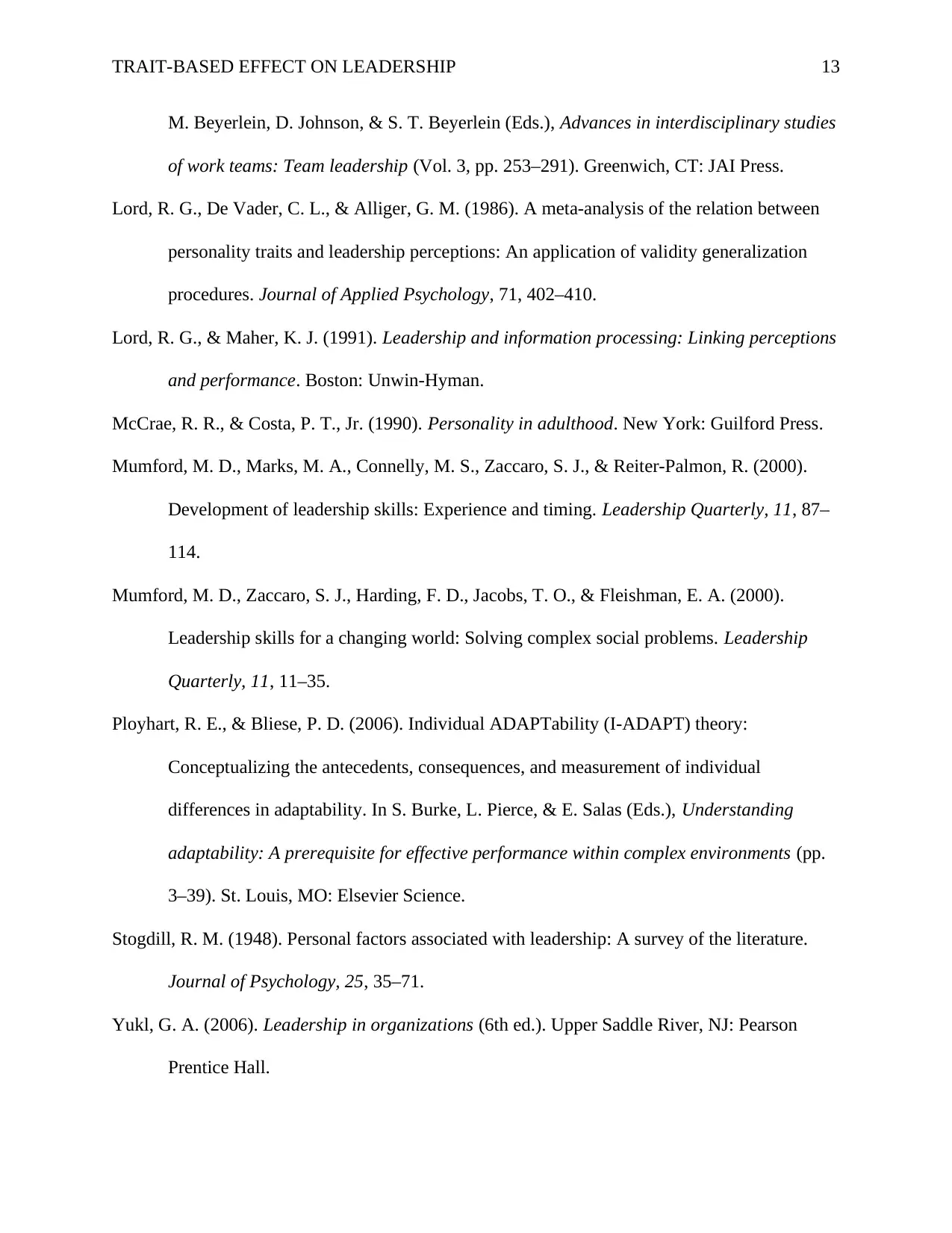
TRAIT-BASED EFFECT ON LEADERSHIP 13
M. Beyerlein, D. Johnson, & S. T. Beyerlein (Eds.), Advances in interdisciplinary studies
of work teams: Team leadership (Vol. 3, pp. 253–291). Greenwich, CT: JAI Press.
Lord, R. G., De Vader, C. L., & Alliger, G. M. (1986). A meta-analysis of the relation between
personality traits and leadership perceptions: An application of validity generalization
procedures. Journal of Applied Psychology, 71, 402–410.
Lord, R. G., & Maher, K. J. (1991). Leadership and information processing: Linking perceptions
and performance. Boston: Unwin-Hyman.
McCrae, R. R., & Costa, P. T., Jr. (1990). Personality in adulthood. New York: Guilford Press.
Mumford, M. D., Marks, M. A., Connelly, M. S., Zaccaro, S. J., & Reiter-Palmon, R. (2000).
Development of leadership skills: Experience and timing. Leadership Quarterly, 11, 87–
114.
Mumford, M. D., Zaccaro, S. J., Harding, F. D., Jacobs, T. O., & Fleishman, E. A. (2000).
Leadership skills for a changing world: Solving complex social problems. Leadership
Quarterly, 11, 11–35.
Ployhart, R. E., & Bliese, P. D. (2006). Individual ADAPTability (I-ADAPT) theory:
Conceptualizing the antecedents, consequences, and measurement of individual
differences in adaptability. In S. Burke, L. Pierce, & E. Salas (Eds.), Understanding
adaptability: A prerequisite for effective performance within complex environments (pp.
3–39). St. Louis, MO: Elsevier Science.
Stogdill, R. M. (1948). Personal factors associated with leadership: A survey of the literature.
Journal of Psychology, 25, 35–71.
Yukl, G. A. (2006). Leadership in organizations (6th ed.). Upper Saddle River, NJ: Pearson
Prentice Hall.
M. Beyerlein, D. Johnson, & S. T. Beyerlein (Eds.), Advances in interdisciplinary studies
of work teams: Team leadership (Vol. 3, pp. 253–291). Greenwich, CT: JAI Press.
Lord, R. G., De Vader, C. L., & Alliger, G. M. (1986). A meta-analysis of the relation between
personality traits and leadership perceptions: An application of validity generalization
procedures. Journal of Applied Psychology, 71, 402–410.
Lord, R. G., & Maher, K. J. (1991). Leadership and information processing: Linking perceptions
and performance. Boston: Unwin-Hyman.
McCrae, R. R., & Costa, P. T., Jr. (1990). Personality in adulthood. New York: Guilford Press.
Mumford, M. D., Marks, M. A., Connelly, M. S., Zaccaro, S. J., & Reiter-Palmon, R. (2000).
Development of leadership skills: Experience and timing. Leadership Quarterly, 11, 87–
114.
Mumford, M. D., Zaccaro, S. J., Harding, F. D., Jacobs, T. O., & Fleishman, E. A. (2000).
Leadership skills for a changing world: Solving complex social problems. Leadership
Quarterly, 11, 11–35.
Ployhart, R. E., & Bliese, P. D. (2006). Individual ADAPTability (I-ADAPT) theory:
Conceptualizing the antecedents, consequences, and measurement of individual
differences in adaptability. In S. Burke, L. Pierce, & E. Salas (Eds.), Understanding
adaptability: A prerequisite for effective performance within complex environments (pp.
3–39). St. Louis, MO: Elsevier Science.
Stogdill, R. M. (1948). Personal factors associated with leadership: A survey of the literature.
Journal of Psychology, 25, 35–71.
Yukl, G. A. (2006). Leadership in organizations (6th ed.). Upper Saddle River, NJ: Pearson
Prentice Hall.
Paraphrase This Document
Need a fresh take? Get an instant paraphrase of this document with our AI Paraphraser
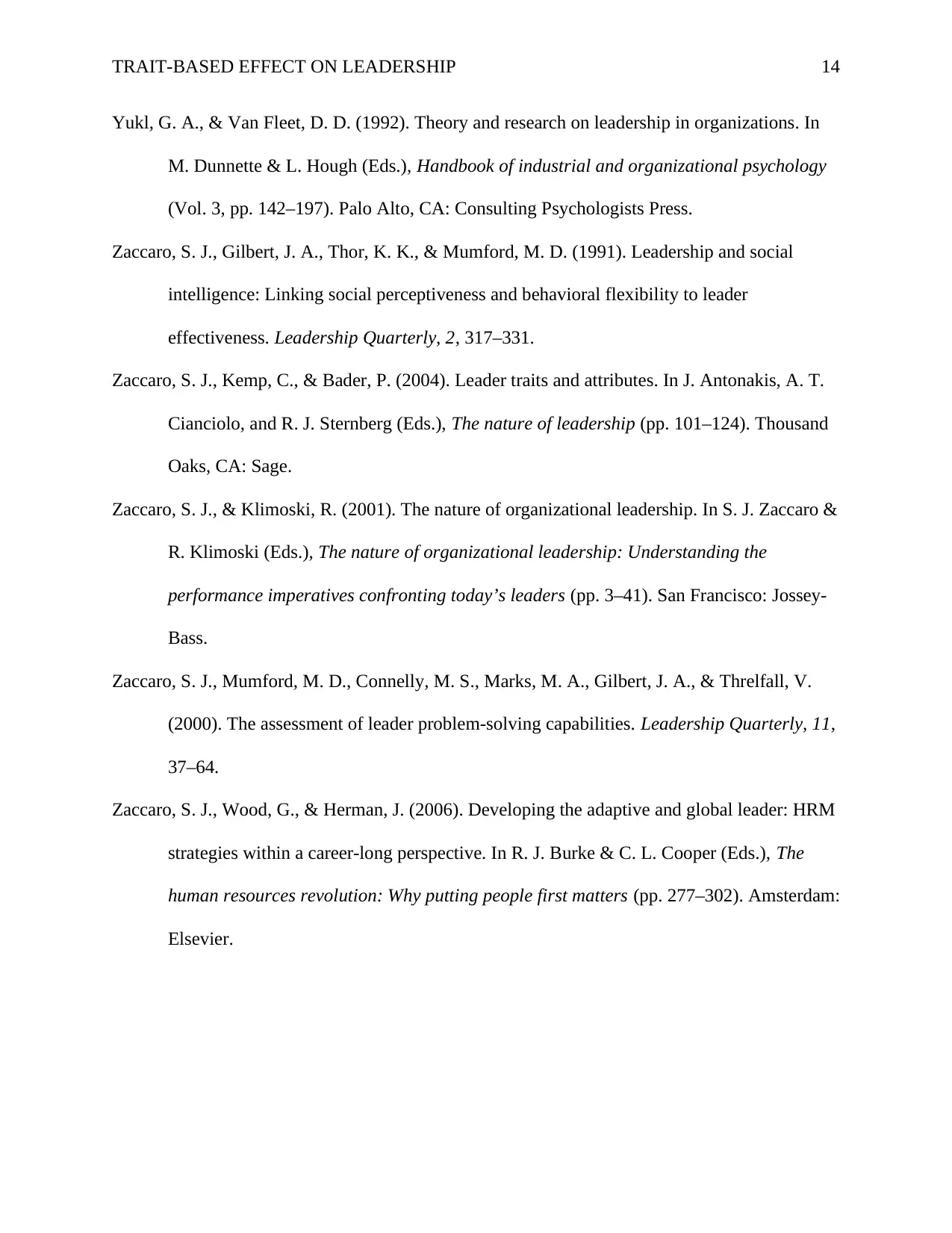
TRAIT-BASED EFFECT ON LEADERSHIP 14
Yukl, G. A., & Van Fleet, D. D. (1992). Theory and research on leadership in organizations. In
M. Dunnette & L. Hough (Eds.), Handbook of industrial and organizational psychology
(Vol. 3, pp. 142–197). Palo Alto, CA: Consulting Psychologists Press.
Zaccaro, S. J., Gilbert, J. A., Thor, K. K., & Mumford, M. D. (1991). Leadership and social
intelligence: Linking social perceptiveness and behavioral flexibility to leader
effectiveness. Leadership Quarterly, 2, 317–331.
Zaccaro, S. J., Kemp, C., & Bader, P. (2004). Leader traits and attributes. In J. Antonakis, A. T.
Cianciolo, and R. J. Sternberg (Eds.), The nature of leadership (pp. 101–124). Thousand
Oaks, CA: Sage.
Zaccaro, S. J., & Klimoski, R. (2001). The nature of organizational leadership. In S. J. Zaccaro &
R. Klimoski (Eds.), The nature of organizational leadership: Understanding the
performance imperatives confronting today’s leaders (pp. 3–41). San Francisco: Jossey-
Bass.
Zaccaro, S. J., Mumford, M. D., Connelly, M. S., Marks, M. A., Gilbert, J. A., & Threlfall, V.
(2000). The assessment of leader problem-solving capabilities. Leadership Quarterly, 11,
37–64.
Zaccaro, S. J., Wood, G., & Herman, J. (2006). Developing the adaptive and global leader: HRM
strategies within a career-long perspective. In R. J. Burke & C. L. Cooper (Eds.), The
human resources revolution: Why putting people first matters (pp. 277–302). Amsterdam:
Elsevier.
Yukl, G. A., & Van Fleet, D. D. (1992). Theory and research on leadership in organizations. In
M. Dunnette & L. Hough (Eds.), Handbook of industrial and organizational psychology
(Vol. 3, pp. 142–197). Palo Alto, CA: Consulting Psychologists Press.
Zaccaro, S. J., Gilbert, J. A., Thor, K. K., & Mumford, M. D. (1991). Leadership and social
intelligence: Linking social perceptiveness and behavioral flexibility to leader
effectiveness. Leadership Quarterly, 2, 317–331.
Zaccaro, S. J., Kemp, C., & Bader, P. (2004). Leader traits and attributes. In J. Antonakis, A. T.
Cianciolo, and R. J. Sternberg (Eds.), The nature of leadership (pp. 101–124). Thousand
Oaks, CA: Sage.
Zaccaro, S. J., & Klimoski, R. (2001). The nature of organizational leadership. In S. J. Zaccaro &
R. Klimoski (Eds.), The nature of organizational leadership: Understanding the
performance imperatives confronting today’s leaders (pp. 3–41). San Francisco: Jossey-
Bass.
Zaccaro, S. J., Mumford, M. D., Connelly, M. S., Marks, M. A., Gilbert, J. A., & Threlfall, V.
(2000). The assessment of leader problem-solving capabilities. Leadership Quarterly, 11,
37–64.
Zaccaro, S. J., Wood, G., & Herman, J. (2006). Developing the adaptive and global leader: HRM
strategies within a career-long perspective. In R. J. Burke & C. L. Cooper (Eds.), The
human resources revolution: Why putting people first matters (pp. 277–302). Amsterdam:
Elsevier.
1 out of 14
Related Documents
Your All-in-One AI-Powered Toolkit for Academic Success.
+13062052269
info@desklib.com
Available 24*7 on WhatsApp / Email
![[object Object]](/_next/static/media/star-bottom.7253800d.svg)
Unlock your academic potential
© 2024 | Zucol Services PVT LTD | All rights reserved.



